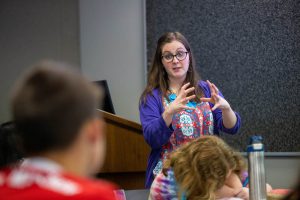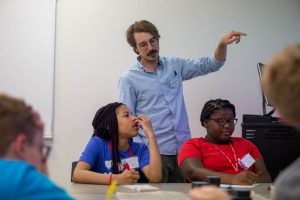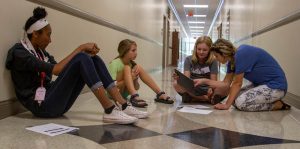by Erika Solberg

We want every SCATS camper to have their best two weeks of summer, but they are not the only participants who love the experience — their teachers often find camp to be the highlight of their year as well. Johni Lecoffre, MAE candidate and teacher for The Modern French Experience, says “I’ve had the time of my life. I’ve been overwhelmed by how awesome these students are. They do amazing work, and they seem so excited about learning. I’m having so much fun with them, and it’s hard for me to remember that ten days ago, I didn’t know any of these students — they’re awesome people, and I’ve loved getting to know them.”
Johni is one of 23 WKU gradate students in gifted studies doing their practicum teaching at SCATS this year. Much like SCATS students, they bring different goals, backgrounds, and interests, but all share the same passion for learning and capacity for growing.

Our graduate students pursue gifted studies for a number of reasons. A common one is the lack of training in teaching gifted students in undergraduate education programs. Art of Mathematics teacher Kendall Ross is pursuing the MAE in gifted education and talent development because “gifted and talented was an area we hardly touched in college. I wanted to know more about kids who excel and how to help them.” MAE student Julie Storch, who is teaching Earthquake-Resistant STEM, explains, “I’ve had a lot of professional development trainings on differentiation, reaching diverse students, and special education, but I haven’t had much on gifted education. I want to be able to provide for those students because they often get the short end of the stick at school, but we need them and their talents.”

Other teachers are drawing on their own experiences as gifted students. Both John Alexander, MAE candidate and teacher for The Crusades, and Johni were identified as gifted and talented as children. John comments, “In elementary school, the teachers did a little bit with me and the other gifted students, but then nothing else really happened. I thought schools just didn’t do those things.” Johni says, “I was accelerated from first grade to third grade. Especially in my middle school years, teachers didn’t always know how to talk to me or what to do with me. I felt weird, and there were a lot of ways I just always felt different. Sometimes a school year would go by where there wasn’t a single person in my classes who was weirdly passionate about the things that I was weirdly passionate about. But having been a gifted student doesn’t automatically translate to knowing how to serve gifted students best as an educator; it has to be paired with strategies and techniques. This program has supported my desire to help gifted students with the knowledge it takes to back up that desire.

The desire to learn about and teach gifted students has translated into a variety of SCATS classes. Angelica Garnett, who is working on her rank one, teaches special education at Trigg County High School and has been a drama coach for the past 13 years: “I work with students who love theater, so I wanted to recreate that at SCATS.” Johni is focusing on France because her husband grew up there, and she wanted to share what she has learned from him as well as her own experiences visiting the country. Kendall chose an interdisciplinary course because “a lot of students don’t get the chance to integrate art into math or math into art. A lot of them are used to equations and maybe an occasional geometry picture, but there’s so much more you can do. We have done the order of operations with sewing, and 3D modelling with food trucks. We’re going to look into the golden ratio and the divine proportion as well.”
Julie felt that her earthquake course “would allow the students’ creativity to shine and allow students of all interests to get involved. It was neat that on the first day camp, there was an earthquake in Cleveland that helped spark their interest.” Her students have used a variety of materials, from index cards to spaghetti noodles. They have also used Slinkys to learn about P-waves and S-waves. Julie makes sure to push her students to think deeply. Last Friday, as a student was making a house from paperclips, Julia questioned him on his plans, pushing him to rethink his design and be creative in using the materials at hand.
John spent a lot of time learning about the Crusades to prepare for his course, but he also designed his own roleplaying game based on Dungeons & Dragons to make the learning as interactive as possible. In the first week, student created characters who were European Crusaders and made decisions in situations based on actual historic events, such as battles, rolling dice to determine their personal outcomes. John explains, “I play D&D religiously — I’ve run games and been a participant, so I already knew how to have a battle simulation and tell a story. The game that I’m running here is loosely based off of a system simplified to make it efficient for learning in class.”
Coming in to SCATS, the teachers’ coursework had given them a solid background, but they knew the two weeks would present plenty of learning opportunities. Kendall says, “A really good surprise is how collaborative the students have been. In one class, a student was stuck on finding the area of a trapezoid, and the others helped him with the formula to get it to equal 36 squared units.” For Angelica, she faced a challenge last week when a make-up activity did not go as planned. In the first period class on Wednesday, the class watched a YouTuber tutorial about how to apply make-up to look elderly, but because the YouTube had different supplies than the students, when they tried it, “it just made a mess on your face.” Instead, in the second period class, they focused on zombie make-up, which the students loved.
John has had to adjust the pacing of his class: “I had originally planned out 10 lessons over 10 days. But the first two lessons took most of last week to complete because the students were getting so into the topic. They have been asking so many great questions, we’ve been spending more time on discussion, and they’ve really gotten into the battle simulations. It’s really good.”

The first few days of SCATS brought challenge for Julie. “It was about communication,” she says. “It was a lot of, ‘What do you want? How do you want to do this? Let me make this happen.’ When they came into my class on the first afternoon, they were worn out — it was the change of pace, the excitement. Our first lesson was about building towers with index cards, and originally I had structure and limitations in the assignment, but their body language showed that they were drained and needed some downtime. So they still did the activity, but I took away all parameters. On the second day, we did pre-assessment, but they were still trying to get that routine down, so we took some materials and built structures just to make it relaxed. But then Wednesday was a total change of pace — they were on it, they were engaged, and they had the swing of things — they didn’t want to leave class.”
Teachers are already seeing the benefits of their SCATS experience. Johni, who teaches third grade at Rockfield Elementary, says, “Teaching the practicum helps me understand how important choice and differentiation are for higher-level kids, and that choice benefits all students. SCATS students appreciate having two or three options, if not more, and I need to make sure that I’m doing that with my third grade students too because they all like choices, and when they’re interested, they’re going to work harder and produce more.” John, who teaches fifth and sixth grade reading and social studies at Austin Tracy Elementary, has benefitted from his classroom observations of other SCATS teachers: “My observations have been enlightening because I’ve seen so many different strategies that I never would have thought of doing — that’s been a piece that I didn’t expect from the camp. I want to try some of the things that I’ve seen, such as how to have a structured debate like in the Never Forget 9/11 class, or incorporating art into certain projects like in the Mythology class. I want to get beyond having a narrow-minded view of how history and social studies can be taught.”
John’s enthusiasm reveal that at SCATS, the teachers are as excited about learning as their students. His excitement was in evidence on the second day of The Crusades, when the lesson involved the siege of Nicaea. After the students’ characters engaged in a fight with the Turks, John asked his class to come up with a solution to the actual problem the Crusaders faced: because Nicaea backed onto a lake, the city was not running out of supplies during the siege. After suggestions from students such as sneaking on board a boat or pouring oil into the lake and lighting it on fire, John filled them in on the actual solution: “Here’s what really happened — knowing it won’t get you into college, but it’s so cool to know this: they rolled their boats over land using logs to get to the lake by Nicaea. This was what broke the city.” The smile on his face over this impressive accomplishment of gifted thinkers long ago matched the awed smiles of his students — a true SCATS moment.
